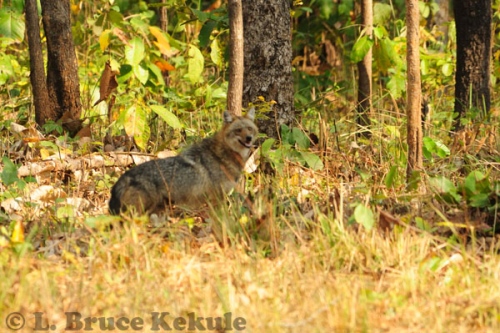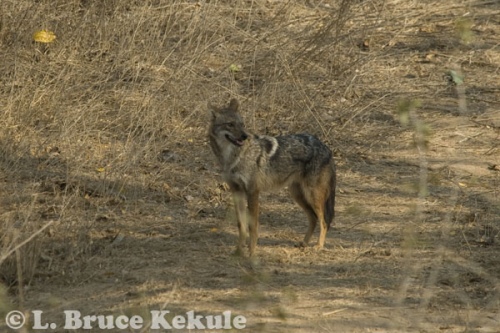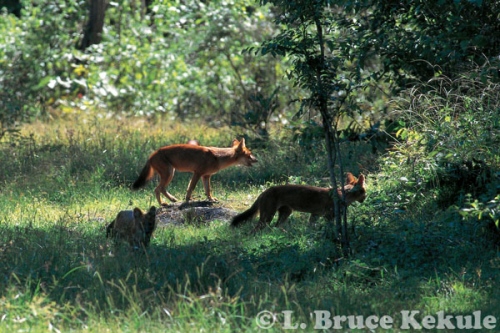Posts Tagged ‘wild dog’
Asian wild dog and Asiatic jackal
Thailand’s forest canids
Fearless carnivores – Stealthy scavengers
It is late afternoon in Huai Kha Khaeng Wildlife Sanctuary in western Thailand, a World Heritage Site. A sambar doe and her fawn at the river for a thirst quenching drink are on high alert. They sense danger and stamp their feet on the ground, and bark in response to a possible threat.
Asian wild dog in Kaeng Krachan National Park
A small pack of seven wild dogs out hunting surround the two deer to confuse and separate them. The mature doe bolts across the shallow waterway making her escape and the dogs pursue the young one. It is not long before the fearless creatures catch the fawn and literally tear the small ungulate apart devouring the little deer in minutes.
Asiatic jackal in Kui Buri National Park
One animal is killed so that others can survive. After that, the dogs drink at the river’s edge. It is raw nature in the purist form and one of the oldest phenomena in the world: survival of the fittest. The female deer carries on to live and breed again as nature intended.
Asian wild dogs by the Huai Kha Khaeng in late afternoon
In another scenario, a lone jackal wanders through the open forest of Kuiburi National Park in southwest Thailand in search of a meal. Its sense of smell is acute. Slightly smaller than the wild dog, the jackal catches the smell of rotting carrion killed by a larger carnivore – probably a tiger or leopard.
Prey species: sambar doe and fawn crossing Huai Kha Khaeng in early morning
It finds a maggot infested deer carcass and feeds on the kill until full, and then seeks out a waterhole for a drink. This stealthy canid has just preformed its task in nature as a useful scavenger cleaning up the environment. It then retires to its burrow until the urge to eat or drink again.
Predation is a very important part of maintaining the ecological balance of life in the forest. The predator – prey relationship is the process of natural selection. Carnivores remove the old and young, plus the sick, the slow or less wary prey animals from the population thus keeping the breeding stock sustainable and strong. They also prevent prey from outgrowing the carry-capacity of an ecosystem thus ensuring balanced harmony.
The forests of Thailand have two species of canid: the Asian wild dog Cuon alpinus and the Asiatic jackal Canis aureus that still thrive in the top protected areas where prey animals are abundant. However, these creatures have unfortunately declined primarily due to habitat loss and destruction, plus unintentional persecution by poachers using snares and poison. Both species are most likely not hunted for their meat but the pelts are valued by some. These carnivores are also despised by many people.
Probably the most feared predator in the forest is the Asian wild dog, also known as the ‘dhole’. The word dhole has an ancient Asiatic root implying daring or recklessness. Rudyard Kipling referred to the wild dog as ‘red peril’ in his well-known tome, ‘The Jungle Book’. He gave a very unsympathetic portrayal, reflecting the age-old prejudice against the species. Its role however, of maintaining the ecological balance and complimenting other predators like the tiger and leopard, is viewed more rationally now.
Asian wild dogs hunt in packs and are true carnivores. They sometimes can take on prey as large as gaur and banteng, and are even known to attack other carnivores like the tiger and leopard. The wild dog is also a very efficient predator devouring almost everything including the meat, bones and hide leaving only parts of the lower intestines for other creatures.
Asian wild dogs camera trapped by the Phetchaburi River
The jackal being a scavenger, are mainly solitary. A male and female will den and hunt together after mating and rearing their young. In addition to scavenging on tiger and leopard kills, they hunt small living creatures such as young deer, rodents, birds, amphibians and reptiles plus insects. They are also omnivorous eating a variety of plant foods. Another trait is to enter villages or camps to scavenge garbage, and to take chickens and ducks. They even raid crops such as sugar cane. Their home range is only two to three square kilometers.
Asiatic Jackal in Huai Kha Khaeng
Several years ago while sitting alone by the Phetchaburi River in Kaeng Krachan National Park in southwest Thailand with my camera at ready during the mid-day, an Asian wild dog popped out of the forest directly across from my position about twenty meters away. I had just finished eating some noodles and laid the bowl on the ground.
As I was dressed in a camouflage suit with my camera, lens and tripod ready and well concealed, the female dog did not notice me. She was part of a pack scouting the river for prey and did not stay long. I was very fortunate and got some amazingly close-up photographs of the dog as seen in the lead photo. I have also camera-trapped many wild dogs at several areas in the park.
Asian wild dog by the Phetchaburi River in Kaeng Krachan
Early this year during the dry season, I made a visit to Kuiburi National Park just south of Kaeng Krachan. Kuiburi is home to many gaur and elephant plus the tiger, leopard and wild dog. I was sitting in a tree stand about ten meters up from a waterhole used by the large mammals. About 5:30pm, I saw a jackal out the corner of my right eye walking up the road. I was using my big Nikon 400mm lens coupled with a 1.7 tele-converter for a total of 680mm. The canid cautiously slinked up to the water’s edge and stayed for sometime drinking while I shot a long series of images. Amazingly, it was the first photographic record of a jackal in the park.
Asiatic jackal near a waterhole in Kui Buri National Park
Another totally unexpected encounter with the jackal also happened early this year in Huai Kha Khaeng. I was driving into the sanctuary when two breeding adults crossed the road in front of my Ford pickup. They high-tailed it but then stopped to stare about 70 meters away. I was able to get a few quick snap-shots of the pair. The rangers at the front gate said the two were raising a small family nearby. I certainly felt lucky at seeing and photographing the two predators.
Wild dog and jackal still thrive in some parts of the following complexes: Western Forest, Dong Phayayen-Khao Yai, Phu Khieo-Nam Nao, Keang Krachan-Kuiburi, Khao Ang Rue Nai-Khao Soi Dow. They also survive in the Mae Ping-Omkoi and other protected forests in the north, plus Hala-Bala and others in the south. Both species are threatened due to numerous problems already addressed.
Dhole camera trapped in Khao Ang Rue Nai Wildlife Sanctuary
My close friend and associate Kate Jenks with the Smithsonian Institute has been researching wild dogs since 2005. She began a research and camera trap program in Khao Yai National Park and gained valuable information on the park’s carnivores. A very large pack of 23 wild dogs was once seen by my friend Mark Reed killing a sambar in the park and it is believed they have replaced the tiger as the top predator here. Several other people have bumped into this pack on the nature trails and they are seen quite often around the headquarters area.
In 2008, Kate then moved to Khao Ang Rue Nai Wildlife Sanctuary in eastern Thailand and began a new collaborative project between scientists at the Smithsonian Conservation Biology Institute, Kasetsart University and the Department of National Parks.
The goals of the project were: conduct ecological studies of the dhole population in the sanctuary; evaluate the disease risk presented by domestic dogs to the health of dholes and the carnivore population; develop and implement an education and outreach initiative for local villagers about the importance of the dhole and other carnivores, and the role of these species in sustaining a healthy Thai ecosystem; and promote long-term conservation of the dhole in Thailand by assembling and sharing all findings at stakeholder workshops to create a feasible conservation action plan for the wild dog in the Kingdom.
Kate carried out camera trapping in Khao Ang Rue Nai in conjunction with the staff at the Chachoengsao Research Unit located in the protected area for over two and a half years placing cameras at 276 locations for a total of 5,794 trap nights. The team documented the presence of one dhole pack with six members. One female was missing a tail. In addition to documenting the distribution of dhole and other wildlife, camera-traps also documented villagers, poachers and domestic dogs in the protected area.
Asian wild dogs in Huai Kha Khaeng
Over the long run, it is vitally important for the Department of National Parks and other responsible agencies to do their utmost to protect and enforce the law in order to save not only the wild dog and the jackal, but all the other species and the ecosystems they live in.
Thailand’s natural heritage has taken millions of years to evolve and it is extremely important for the present and future generations to love and cherish this treasure. Mother Nature needs our concerted efforts and respect to survive. In the event you love nature, do your part, no matter how big or small, and she will surely reward you.
Ecology: The Asian wild dog
Described by Pallas in 1811, the Asian wild dog is a highly social creature sometimes living in large packs of twenty or more. They occasionally split up into smaller groups to hunt. These dogs are fearful of humans but are bold enough to attack large and dangerous animals such as wild boar, water buffalo and tigers. Dholes are post-Pleistocene in origin, and are more closely related to jackals than they are to wolves. It is thought they became social animals as an adaptation to living with tigers and leopards.
They usually live in fertile primary forest where there are many herbivores, and are more abundant in riverine evergreen forest than in mixed deciduous forest. The dhole usually hunt in the day and retire to their dens at night. While hunting, they use their olfactory sense to follow and find prey while taking turns to chase animals until exhausted. They mostly eat their prey live but will occasionally take in carrion depending on conditions.
The overall body length of the dhole is from 80-135 cm. and the tail is 28-48 cm. long. The males weigh from 10-21 kg. and the female from 10-13 kg. The muzzle is shorter than that of most canid with a large nose pad. Their ears are rounded, erect and short with white hair inside. The coat is reddish-brown, the belly white and the tail is black. They are found in Siberia, Korean peninsula, Mongolia down to the Indian sub-continent and across to Southeast Asia including Thailand, Laos, Cambodia, Burma, Malaysia, Sumatra and Java. In Thailand, there are two sub-species: Cuon alpinus adustus North of the Istmas of Kra, and C.a. sumatrensis to the South.
Ecology: The Asiatic jackal
Described by Linnaeus in 1758, the Asiatic jackal also known as the golden jackal is related to the wolf. They are smaller than the dhole but bigger than the red fox. The body of the jackal is 60-70 cm. long with a tail at 20-25 cm., and they weigh 8-9 kg. These omnivores are slim and generally grayish-brown to golden-brown depending on the season, with black-tipped hairs on the shoulders and back tending to form a saddle-like pattern. Their ears are broadly pointed, and the tail bushy and black at the tip.
They prefer drier, open areas and are usually seen singly or in pairs. Jackals call just after dusk and before dawn. Generally tolerant of human disturbance but the species has declined in many areas due to excessive trapping.
Two sub-species are found in Asia: Canis aureus indicus found in Nepal, Bhutan, Assam across Burma and Thailand. The other is C.a. hola found in Palunpur and Gujarat in the southeast of India. Other jackal sub-species are found from the Balkan peninsula in the east of Europe to east Africa through to Turkey, Iraq, central and south Iran to the Indian sub-continent. The jackal is a very versatile species and one of nature’s clean-up crew and needs total protection like all the other denizens of the Thai forest.











